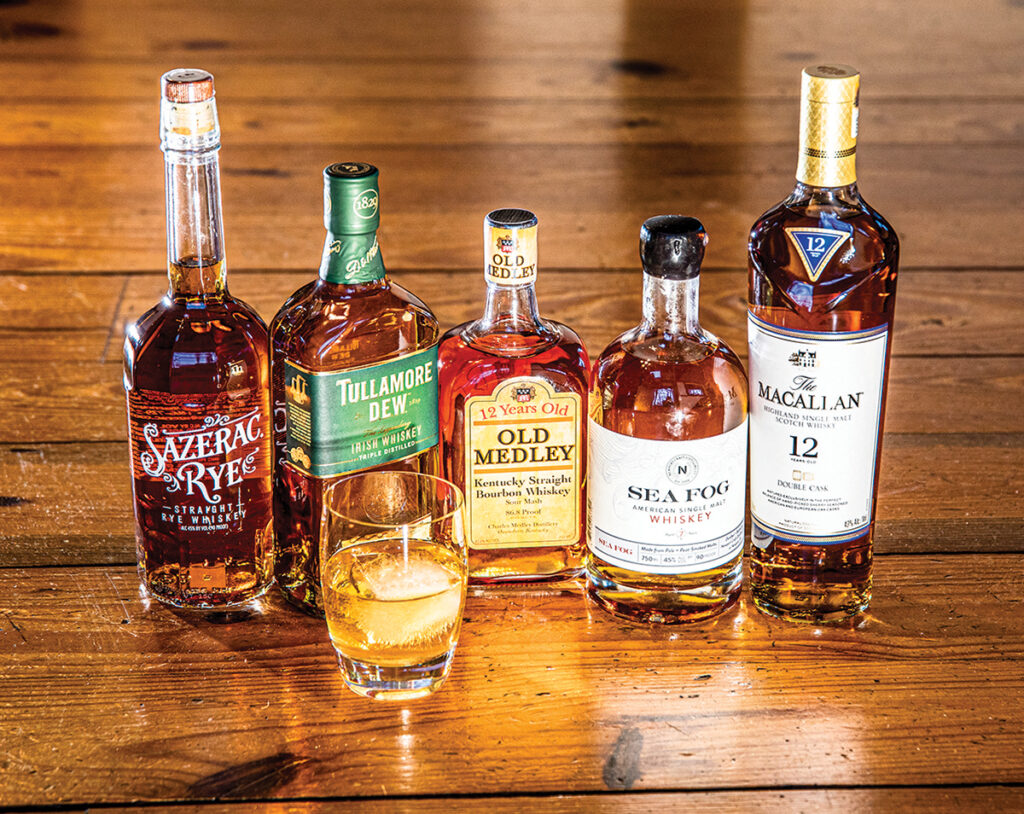Wine has always had a prominent place at business and family gatherings. Think about how many networking or sales dinners include wine. Look at the holidays – the day before any major holiday is the biggest shopping day for wine. However, the beautiful, brown, warming spirit – whiskey – has been nudging itself in and now has a place, front and center, at both business and family gatherings.
What is whiskey?
Whiskey is a general term that refers to a category of spirits with varied styles and types – Irish, Scotch, American, Japanese, bourbon, rye, Canadian and so on. I often make an analogy to milk when talking whiskey. Milk is a general term that includes skim, 1%, 2%, whole, soy, almond, coconut, oat and each one gives different flavors and weight. It’s the same for whiskey; each type brings its own unique tastes.
Personally, I love whiskey and its classic cocktails – Manhattan and old-fashioned. Yet, I also like to sip a 15-year Irish whiskey or something from Rhode Island’s Sons of Liberty Spirits Co. or Newport Craft Brewing and Distilling Co. Whiskey today affords us much more creativity than just the classic cocktails, with the availability of quality mixing ingredients, bitters and liqueurs.
Whiskey has come a long way, and its popularity now runs the spectrum, from millennials to baby boomers. Women have helped lead the whiskey renaissance; the percentage of women buying whiskey has increased dramatically in the last 10 years. And the plethora of ways to enjoy cocktails has brought forth new whiskey audiences.
While I could fill pages on the production rules of whiskeys, the key is to understand their general differences to help you expand your brown-spirit repertoire. Of course, during March with St. Patrick’s Day celebrations, Irish whiskey will be the choice for many.
[caption id="attachment_323153" align="aligncenter" width="1024"]

DIVERSE GROUP: Whiskey is available in many styles and types. / COURTESY THE SAVORY GRAPE[/caption]
Bourbon and rye whiskeys
Bourbon has become the go-to whiskey. It’s a great starter one to dip your palate into, as it exudes sweeter brown sugar, vanilla and coconut notes, resulting from the corn in its production. Bourbon must be made from at least 51% corn, and in the U.S. (There’s a misconception that all bourbon comes from Kentucky. It does not.) Rye whiskey gives us more edgy, assertive flavors, dominated by spice and less on sweetness. It’s often bolder than bourbon. Rye whiskey must be made from at least 51% rye. It can come from the U.S. or Canada. Both must be aged in charred new oak barrels, which impart much of the flavors and provide the beautiful color of whiskey.
Scotch, Irish and beyond
Then there are the other prominent ones – Scotch whisky and Irish whiskey. Their taste differences compared with bourbon or rye result from location, ingredients and production. Scotch and Irish whiskey are from Scotland and Ireland, respectively. While different, they’re made from malted barley and other unmalted grains. (Single malt is made just from malted barley.) Like other whiskeys, Irish and Scotch also age in oak barrels. Oak barrels – how they’re toasted, their size, age and origination – combined with ingredients determine a whiskey’s final taste. Scotch and Irish whiskey give us the best of all worlds with varied styles – from smoky/peaty Scotch, to 12- or 15-year age Scotch, to sweeter port-cask Irish ones. And we haven’t delved into Japanese or Taiwanese whiskeys.
Conduct your own tasting, whether you’re a newbie or longtime connoisseur, to start or add to your collection. If you’re local, visit Newport Craft or Sons of Liberty for a sampling. Here are some of my top picks for quality and price.
Bourbon – 1792 Small Batch Bourbon
Irish – West Cork 12-year single-malt port cask
American – Newport Craft Sea Fog Whiskey
Scotch – The Macallan 12-year double cask
Rye – Sazerac Rye
Jessica Norris Granatiero is the founder of The Savory Grape, a wine, beer and spirits shop in East Greenwich.













